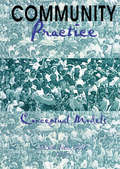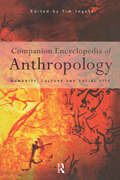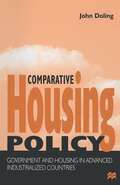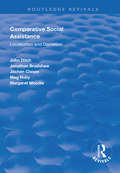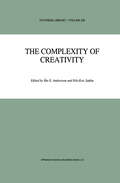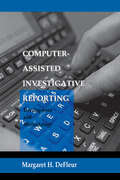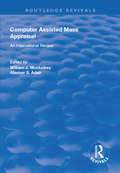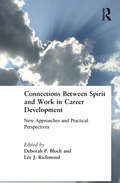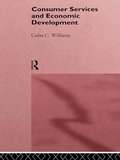- Table View
- List View
Community Practice: Conceptual Models
by Marie WeilHere is the only book that gives you a comparison of model frameworks and a critique of multiple perspectives. Community Practice: Conceptual Models (along with its companion volume, Community Practice: Models in Action) illustrates the diverse ways that community practice is conceived and delineates both the central and subtle differences among models to guide community assessment, action planning, and practice. By knitting together the complex ideas from the social sciences and community practice, this book shows how to combine these ideas to improve teaching, practice, analysis, and research for social work faculty; social work students; practitioners in community work, administration, and social planning; and faculty of related disciplines.The scope of Community Practice: Conceptual Models is broad, providing the first historical report on model development and implementation since 1965. Its chapters present diverse views on community practice approaches and provide the compilation, critique, and analysis of current models --while illustrating how these approaches developed over time. Included is Rothman’s long-awaited revision and elaboration of his 1970s classic, three models conceptual framework. Other vital topics you learn about include: collaborative community development social planning, reform movements, and social action ecological theory in community practice a feminist response and critique to Rothman’s approaches to community intervention a comparison of community practice in the U.S. and U.K., with an emphasis on nonracist practice and community-based service developmentCommunity Practice: Conceptual Models offers challenges and indicates directions for practice, theory elaboration, testing, and research and shows community practice in relation to characteristics such as goals and desired outcomes, change strategies, targets of change, primary constituencies, and focus or scope of concern. This book provides the strongest perspectives on community practice to help you improve your practice, assessments, action plans, and research.
Community Practice: Conceptual Models
by Marie WeilHere is the only book that gives you a comparison of model frameworks and a critique of multiple perspectives. Community Practice: Conceptual Models (along with its companion volume, Community Practice: Models in Action) illustrates the diverse ways that community practice is conceived and delineates both the central and subtle differences among models to guide community assessment, action planning, and practice. By knitting together the complex ideas from the social sciences and community practice, this book shows how to combine these ideas to improve teaching, practice, analysis, and research for social work faculty; social work students; practitioners in community work, administration, and social planning; and faculty of related disciplines.The scope of Community Practice: Conceptual Models is broad, providing the first historical report on model development and implementation since 1965. Its chapters present diverse views on community practice approaches and provide the compilation, critique, and analysis of current models --while illustrating how these approaches developed over time. Included is Rothman’s long-awaited revision and elaboration of his 1970s classic, three models conceptual framework. Other vital topics you learn about include: collaborative community development social planning, reform movements, and social action ecological theory in community practice a feminist response and critique to Rothman’s approaches to community intervention a comparison of community practice in the U.S. and U.K., with an emphasis on nonracist practice and community-based service developmentCommunity Practice: Conceptual Models offers challenges and indicates directions for practice, theory elaboration, testing, and research and shows community practice in relation to characteristics such as goals and desired outcomes, change strategies, targets of change, primary constituencies, and focus or scope of concern. This book provides the strongest perspectives on community practice to help you improve your practice, assessments, action plans, and research.
Companion Encyclopaedia of Anthropology
by Tim IngoldThis comprehensive survey of contemporary thought in biological, social and cultural anthropology sets the foundation for their future development and integration. The principal rationale behind the Encyclopedia is to overcome the division and fragmentation within the approaches of the humanities and natural sciences to anthropology. It emphasizes interconnections between perspectives and sub-disciplines, producing a complete perspective on what it means to be human. The work consists of three parts--Humanity, Culture, and Social Life--and 40 major contributions. Part One emphasizes human beings as members of a species, how that species differs from others, how it has evolved, and how human populations have adapted to and in turn transformed their environments. Part Two deals with the origin and structure of human culture, and on the role of culture in action, perception, and cognition. Part Three examines the various aspects of the relationships and processes that are carried on by persons and groups in the course of social life. Useful features such as cross-references within the text, full biographical references, suggestions for further reading and carefully illustrated line drawings make this an indispensable resource for all students of anthropology or sociology.
Companion Encyclopaedia of Anthropology: Humanity, Culture And Social Life
by Tim IngoldThis comprehensive survey of contemporary thought in biological, social and cultural anthropology sets the foundation for their future development and integration. The principal rationale behind the Encyclopedia is to overcome the division and fragmentation within the approaches of the humanities and natural sciences to anthropology. It emphasizes interconnections between perspectives and sub-disciplines, producing a complete perspective on what it means to be human. The work consists of three parts--Humanity, Culture, and Social Life--and 40 major contributions. Part One emphasizes human beings as members of a species, how that species differs from others, how it has evolved, and how human populations have adapted to and in turn transformed their environments. Part Two deals with the origin and structure of human culture, and on the role of culture in action, perception, and cognition. Part Three examines the various aspects of the relationships and processes that are carried on by persons and groups in the course of social life. Useful features such as cross-references within the text, full biographical references, suggestions for further reading and carefully illustrated line drawings make this an indispensable resource for all students of anthropology or sociology.
The Company She Keeps (UK Higher Education OUP Humanities & Social Sciences Women's Studies)
by Valerie HeyThis lively and revealing study explores a sociologically invisible but important social relationship: girls' friendships. It uncovers often suppressed school-girl cultures, at times representing in their most condensed and dramatic form issues of intimacy, secrecy and struggle. Most women have memories of, and most mothers of young daughters become re-immersed in, these all-consuming but little understood passions. This taken-for-granted 'ordinary' relationship is examined using girls' notes, talk, diaries and interviews gathered by observing girls groups within city schools.An important and previously ignored question is addressed by examining how girls' intimacy is structured through class, gender, sexuality and race, especially its paradoxical role in maintaining and challenging 'compulsory heterosexuality'. In this way, a series of case studies analyses how girls variously come to understand and construct "difference". In addition, this detailed analysis of girls' friendship contributes to our understanding of how girls simultaneously survive their schools, their families, their relations and subordination to boys and men.Valerie Hey returns the reader to the terrain of loss and recollection, of girls' pleasure and pain in their friendship, and asserts the claims of the social through identifying how this is written into the cultural forms of girls' relationships with each other. Students of women's studies, education, sociology and social psychology will find this book to be an invaluable exploration of how every-day 'obvious' experience is played out as forms of subjectivity and power.
Comparative Housing Policy: Government and Housing in Advanced Industrialized Countries
by John DolingThis text introduces the reader to the comparative study of housing policy. It looks first at the benefits, limitations and difficulties of the comparative method, as well as the reasons behind governmental involvement in housing and particular policy choices. It then identifies and discusses key themes of value to the analysis of a range of countries in the advanced capitalist world, offering an understanding of national differences and similarities and drawing on examples from, for instance, Europe, the USA, Australia and Japan.
Comparative Social Assistance: Localisation and Discretion (Routledge Revivals)
by John Ditch Jonathan Bradshaw Jochen Clasen Meg Huby Margaret MoodiePublished in 1997, the is the report of a study commissioned by the Department of Social Security (UK). The aim of the study was to provide detailed information about the social assistance systems of four European countries which, to a greater or lesser extent, are delegated to local levels of government. The study distinguished between policy-making, finances, delivery and accountability. The strengths and weaknesses of each system were evaluated and common and divergent trends noted. There is growing interest in social assistance schemes internationally and this publication provides original information about European schemes. It follows an earlier study, also commissioned by the DSS, on social assistance schemes in 24 OECD countries.
Comparative Social Assistance: Localisation and Discretion (Routledge Revivals)
by John Ditch Jonathan Bradshaw Jochen Clasen Meg Huby Margaret MoodiePublished in 1997, the is the report of a study commissioned by the Department of Social Security (UK). The aim of the study was to provide detailed information about the social assistance systems of four European countries which, to a greater or lesser extent, are delegated to local levels of government. The study distinguished between policy-making, finances, delivery and accountability. The strengths and weaknesses of each system were evaluated and common and divergent trends noted. There is growing interest in social assistance schemes internationally and this publication provides original information about European schemes. It follows an earlier study, also commissioned by the DSS, on social assistance schemes in 24 OECD countries.
The Complexity of Creativity (Synthese Library #258)
by Ake E. Andersson N. E. SahlinThis is a volume on the concepts, theories, models and social consequences of creativity. It contains articles by well-known cognitive scientists, economists, mathematicians, philosophers and psychologists.
Computer-assisted Investigative Reporting: Development and Methodology
by Margaret H. DeFleurConducting computer analyses for the purposes of revealing information of significance to the press represents an extension of one of the most important forms of American journalism into the contemporary era of new technologies. Investigative reporting had its start with the establishment of the metropolitan newspaper during the early decades of the 1900s. At the time, it was a continuation of the evolving tradition of freedom of the press that had characterized American political life since colonial times. As it developed, investigative reporting stressed facts rather than the opinions of the editor or reporter. In turn, that tradition had its own intellectual roots. Today, computer-assisted investigative reporting (CAIR) extends that "marketplace of ideas" into systematic examinations of the electronic records of government. In addition, computer analyses of other kinds of information systematically gathered by journalists can provide the press with insights into trends and patterns unlikely to be revealed by other means. This unique volume addresses procedures and issues in investigative journalism that have not been explained in other publications. It sets forth -- for the first time -- a detailed and specific methodology for conducting computer-assisted investigative analyses of both large and small scale electronic records of government and other agencies. That methodology consists of the logic of inquiry, strategies for reaching valid conclusions, and rules for reporting what has been revealed by the analyses to the public in clear ways. Such systematic methodologies are essential in social and other sciences and the development of a counterpart for investigative journalism has been badly needed. That systematic methodology is developed within a context that explains the origin and major characteristics of those elements that have come together in American society to make computer-assisted investigative reporting both possible and increasingly a part of standard newsroom practices. These include the development of traditional investigative journalism, the evolution of computer technology, the use of computers by government to keep records, the legal evolution of freedom of information laws, the rapid adoption of computers in newsrooms, the increasing importance of precision journalism, and the sharp increase in recent times of computer-assisted investigative reporting by American newspapers both large and small. The issues addressed in this book are discussed in a very readable context with an abundance of examples and illustrations drawn from the real world of journalism as it is practiced daily in newsrooms around the country. Explanations of concepts, principles, and procedures are set forth in layperson's terms that require very little in the way of knowledge of computers or statistical methods.
Computer-assisted Investigative Reporting: Development and Methodology
by Margaret H. DeFleurConducting computer analyses for the purposes of revealing information of significance to the press represents an extension of one of the most important forms of American journalism into the contemporary era of new technologies. Investigative reporting had its start with the establishment of the metropolitan newspaper during the early decades of the 1900s. At the time, it was a continuation of the evolving tradition of freedom of the press that had characterized American political life since colonial times. As it developed, investigative reporting stressed facts rather than the opinions of the editor or reporter. In turn, that tradition had its own intellectual roots. Today, computer-assisted investigative reporting (CAIR) extends that "marketplace of ideas" into systematic examinations of the electronic records of government. In addition, computer analyses of other kinds of information systematically gathered by journalists can provide the press with insights into trends and patterns unlikely to be revealed by other means. This unique volume addresses procedures and issues in investigative journalism that have not been explained in other publications. It sets forth -- for the first time -- a detailed and specific methodology for conducting computer-assisted investigative analyses of both large and small scale electronic records of government and other agencies. That methodology consists of the logic of inquiry, strategies for reaching valid conclusions, and rules for reporting what has been revealed by the analyses to the public in clear ways. Such systematic methodologies are essential in social and other sciences and the development of a counterpart for investigative journalism has been badly needed. That systematic methodology is developed within a context that explains the origin and major characteristics of those elements that have come together in American society to make computer-assisted investigative reporting both possible and increasingly a part of standard newsroom practices. These include the development of traditional investigative journalism, the evolution of computer technology, the use of computers by government to keep records, the legal evolution of freedom of information laws, the rapid adoption of computers in newsrooms, the increasing importance of precision journalism, and the sharp increase in recent times of computer-assisted investigative reporting by American newspapers both large and small. The issues addressed in this book are discussed in a very readable context with an abundance of examples and illustrations drawn from the real world of journalism as it is practiced daily in newsrooms around the country. Explanations of concepts, principles, and procedures are set forth in layperson's terms that require very little in the way of knowledge of computers or statistical methods.
Computer Assisted Mass Appraisal: An International Review (Routledge Revivals)
by William J. McCluskey Alastair AdairFirst published in 1997, this volume emerged in response to the need for material on the research, development, use and application of mass appraisal techniques for ad valorem property tax systems. The primary paradigms discussed include regression, base home technique, adaptive estimation procedure and artificial neural networks. Intending to address a wide range of property types, the authors explored residential, condominiums, retail, office and industrial property as well as agricultural and forestry land.
Computer Assisted Mass Appraisal: An International Review (Routledge Revivals)
by William J. McCluskey Alastair AdairFirst published in 1997, this volume emerged in response to the need for material on the research, development, use and application of mass appraisal techniques for ad valorem property tax systems. The primary paradigms discussed include regression, base home technique, adaptive estimation procedure and artificial neural networks. Intending to address a wide range of property types, the authors explored residential, condominiums, retail, office and industrial property as well as agricultural and forestry land.
Connections Between Spirit and Work in Career Development: New Approaches and Practical Perspectives
by Deborah P Bloch Lee RichmondIn an age of organizational restructuring and career uncertainty, with upward mobility becoming less and less attainable, how do people find meaning and fulfilment in their work? This book addresses this critical question, offering valuable, concrete suggestions to career development professionals working with clients who long to infuse their work with values. Featuring the insights of leading counsellors and career development practitioners, educators, psychologists, clergy, and management experts, the eleven chapters in Connections Between Spirit and Work in Career Development explain how money, age, gender, and spirituality affect job satisfaction. The authors examine changes that enhance the sense of wholeness in a career, offering illuminating examples showing how people have achieved the goal of balancing work, family life, relationships, and spiritual practice. Responding to the rapidly changing terrain of contemporary work life, this volume presents an extraordinary range of tools and options for career development professionals in their work with their clients.
Connections Between Spirit and Work in Career Development: New Approaches and Practical Perspectives
by Deborah P Bloch Lee RichmondIn an age of organizational restructuring and career uncertainty, with upward mobility becoming less and less attainable, how do people find meaning and fulfilment in their work? This book addresses this critical question, offering valuable, concrete suggestions to career development professionals working with clients who long to infuse their work with values. Featuring the insights of leading counsellors and career development practitioners, educators, psychologists, clergy, and management experts, the eleven chapters in Connections Between Spirit and Work in Career Development explain how money, age, gender, and spirituality affect job satisfaction. The authors examine changes that enhance the sense of wholeness in a career, offering illuminating examples showing how people have achieved the goal of balancing work, family life, relationships, and spiritual practice. Responding to the rapidly changing terrain of contemporary work life, this volume presents an extraordinary range of tools and options for career development professionals in their work with their clients.
Consumer Services and Economic Development
by Colin C. WilliamsConsumer Services have been viewed as parasitic activities, dependent on other sectors of the economy for their viability and vitality. Yet local economic policy is now looking towards consumer services to solve severe economic problems. The rapid expansion of the service sector is now a principal feature of contemporary global economic restructuri
Consumer Services and Economic Development
by Colin C. WilliamsConsumer Services have been viewed as parasitic activities, dependent on other sectors of the economy for their viability and vitality. Yet local economic policy is now looking towards consumer services to solve severe economic problems. The rapid expansion of the service sector is now a principal feature of contemporary global economic restructuri
Consuming Cultures: Feminist Review Issue 55
by The Feminist Review CollectiveConsuming Cultures is concerned with the interrelationship of gender and the circuits of consumption, distribution, production and reproduction. The book looks at the ways in which gender intervenes in all parts of the circuit or the linkages between different elements.
Consuming Cultures: Feminist Review Issue 55
by The Feminist The Feminist Review CollectiveConsuming Cultures is concerned with the interrelationship of gender and the circuits of consumption, distribution, production and reproduction. The book looks at the ways in which gender intervenes in all parts of the circuit or the linkages between different elements.
Consuming Geographies: We Are Where We Eat
by David Bell Gill ValentineFood occupies a seemingly mundane position in all our lives, yet the ways we think about shopping, cooking and eating are actually intensely reflexive. The daily pick and mix of our eating habits is one way we experience spatial scale. From the relationship of our food intake to our body-shape, to the impact of our tastes upon global food-production regimes, we all read food consumption as a practice which impacts on our sense of place.Drawing on anthropological, sociological and cultural readings of food consumption, as well as empirical material on shopping, cooking, food technology and the food media, this book demonstrates the importance of space and place in identity formation. We all think place (and) identity through food - we are where we eat!
Consuming Geographies: We Are Where We Eat
by David Bell Gill ValentineFood occupies a seemingly mundane position in all our lives, yet the ways we think about shopping, cooking and eating are actually intensely reflexive. The daily pick and mix of our eating habits is one way we experience spatial scale. From the relationship of our food intake to our body-shape, to the impact of our tastes upon global food-production regimes, we all read food consumption as a practice which impacts on our sense of place.Drawing on anthropological, sociological and cultural readings of food consumption, as well as empirical material on shopping, cooking, food technology and the food media, this book demonstrates the importance of space and place in identity formation. We all think place (and) identity through food - we are where we eat!
Contemporary Perspectives On Masculinity: Men, Women, And Politics In Modern Society, Second Edition
by Ken ClatterbaughWhat is social reality for men in modern society? What maintains or explains this social reality? What condition might we imagine that would be better for men? How might we achieve this better condition? These are the questions Kenneth Clatterbaugh brings to seven different visions of men in modern society considered in this newly updated edition. In clear and insightful language, Clatterbaugh surveys not just conservative, liberal, and radical views of masculinity, but also the alternatives offered by the men's rights movement, spiritual growth advocates, and black and gay rights activists. Each of these is explored both as a theoretical perspective and as a social movement, and each offers distinctive responses to the questions posed.The first edition of this book was the first to survey the range of responses to feminism that men have made as well as the first to put political theory at the center of men's awareness of their own masculinity. This new edition adds chapters on recent highly-publicized movements such at the Promise Keepers, Million Man March, and the evolution of gay men's rights. Clatterbaugh treats all views with fairness and timeliness as he develops and defends a vision of men and masculinity consistent with feminist ideals and a just society.
Contemporary Perspectives On Masculinity: Men, Women, And Politics In Modern Society, Second Edition
by Ken ClatterbaughWhat is social reality for men in modern society? What maintains or explains this social reality? What condition might we imagine that would be better for men? How might we achieve this better condition? These are the questions Kenneth Clatterbaugh brings to seven different visions of men in modern society considered in this newly updated edition. In clear and insightful language, Clatterbaugh surveys not just conservative, liberal, and radical views of masculinity, but also the alternatives offered by the men's rights movement, spiritual growth advocates, and black and gay rights activists. Each of these is explored both as a theoretical perspective and as a social movement, and each offers distinctive responses to the questions posed.The first edition of this book was the first to survey the range of responses to feminism that men have made as well as the first to put political theory at the center of men's awareness of their own masculinity. This new edition adds chapters on recent highly-publicized movements such at the Promise Keepers, Million Man March, and the evolution of gay men's rights. Clatterbaugh treats all views with fairness and timeliness as he develops and defends a vision of men and masculinity consistent with feminist ideals and a just society.
Contested Countryside Cultures: Rurality and Socio-cultural Marginalisation
by Paul Cloke Jo LittleThis book examines the 'other' side of the countryside, a place also inhabited (and visited) by women, children, teenagers, the elderly, gay men and lesbians, black and ethnic minorities, the unemployed and the poor. These groups have remained largely excluded by both rural policies and the representations of rural culture. The book charts the experiences of these marginalised groups and sets this exploration within the context of postmodern, poststructuralist, postcolonial and late feminist analysis. This theoretical framework reveals how notions of the rural have been created to reflect and reinforce divisions amongst those living in the countryside.
Contested Countryside Cultures: Rurality and Socio-cultural Marginalisation
by Paul Cloke Jo LittleThis book examines the 'other' side of the countryside, a place also inhabited (and visited) by women, children, teenagers, the elderly, gay men and lesbians, black and ethnic minorities, the unemployed and the poor. These groups have remained largely excluded by both rural policies and the representations of rural culture. The book charts the experiences of these marginalised groups and sets this exploration within the context of postmodern, poststructuralist, postcolonial and late feminist analysis. This theoretical framework reveals how notions of the rural have been created to reflect and reinforce divisions amongst those living in the countryside.
